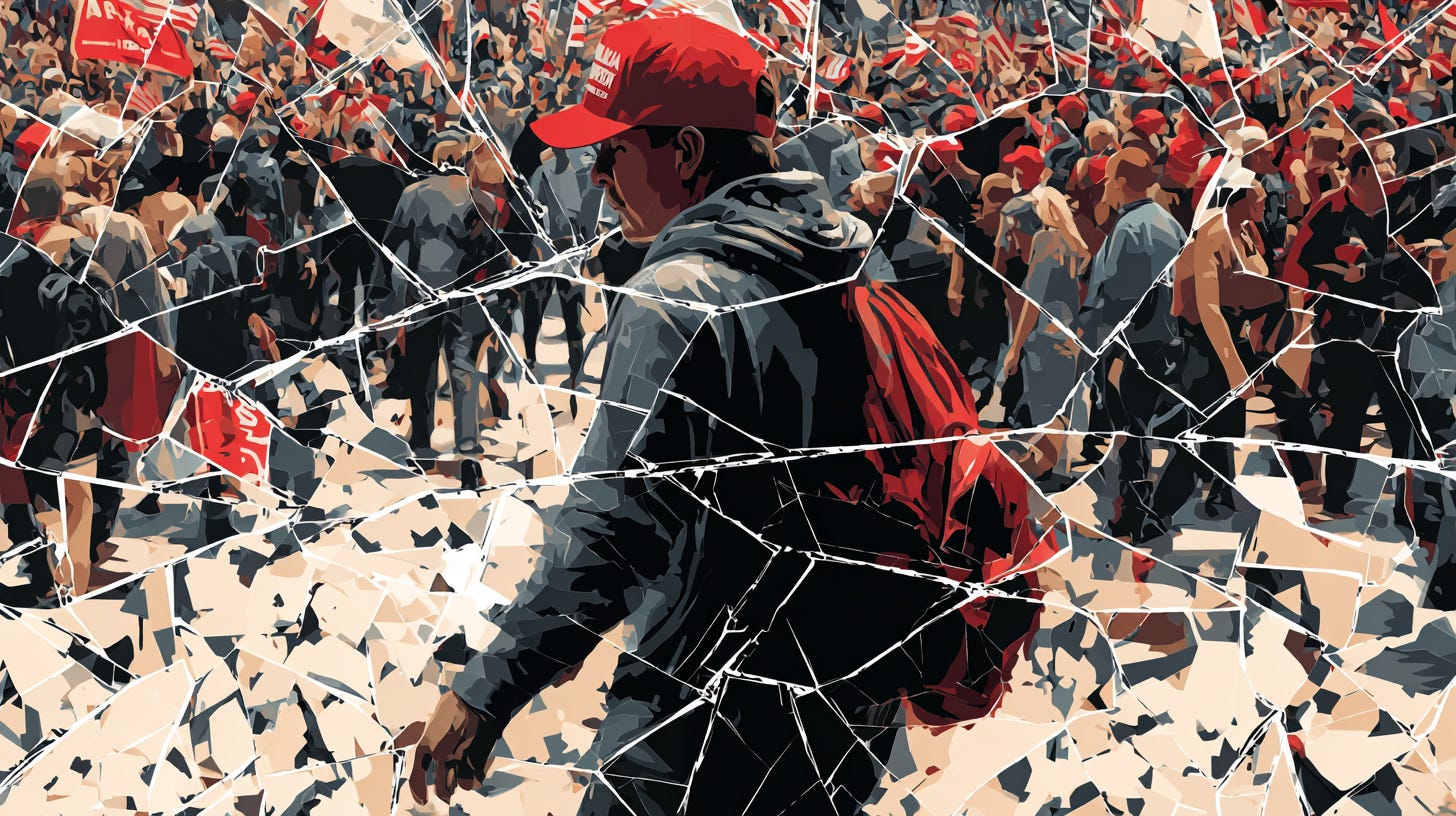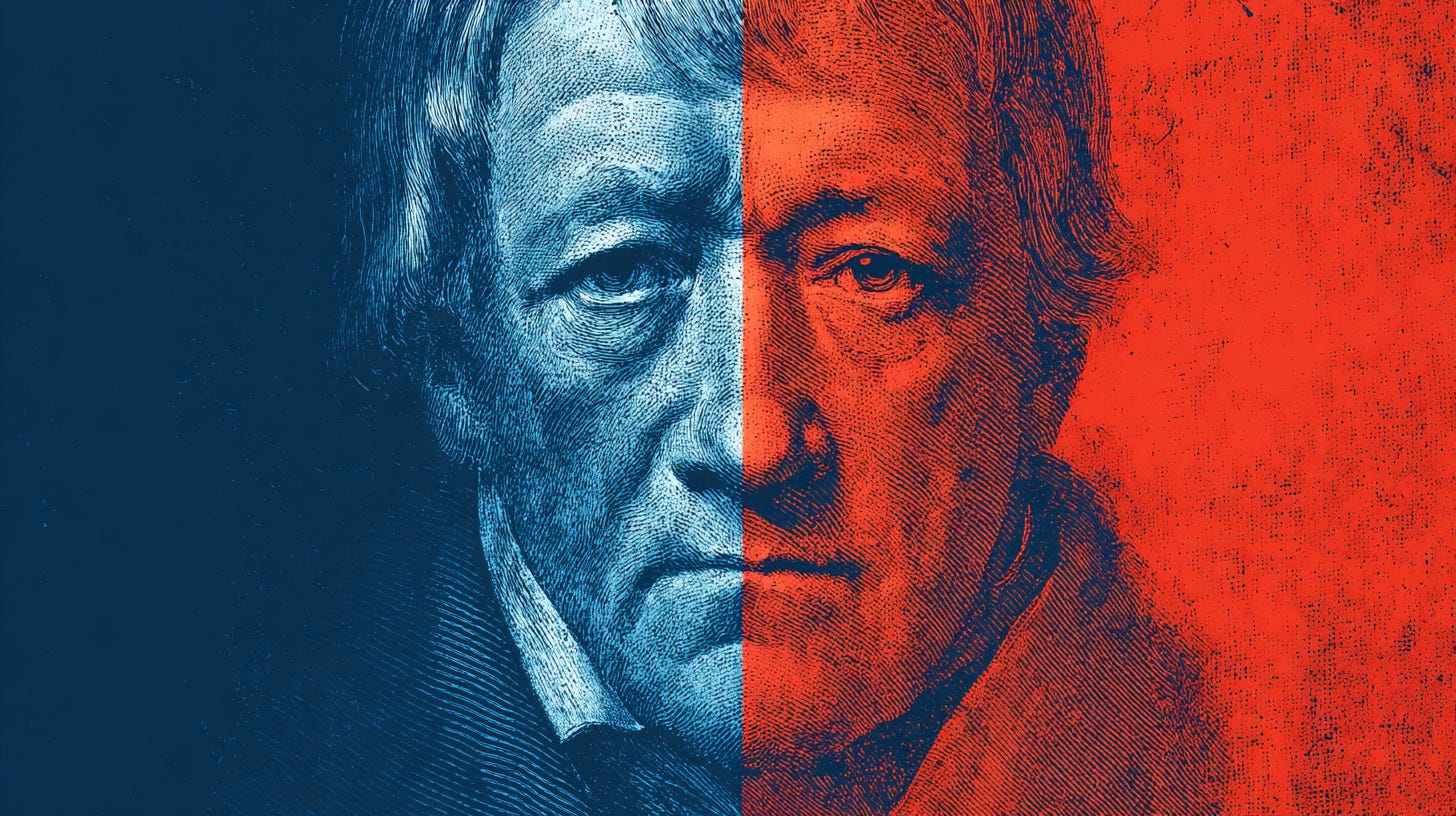The Three-Way War That’s Redefining Western Politics
Progressives, populists, and classical liberals no longer speak the same political language. Their clash is reshaping every debate from free speech to national identity.
The Right’s Civil War
There’s a not-so-quiet civil war unfolding on the political right.
On one side are the old-guard conservatives—the policy nerds, free-marketers, and traditionalists who still speak the language of classic conservatism. On the other are the insurgents—the nationalists, post-liberals, and populists who think the time for talk is over.
They agree on the symptoms: that the West is in decline, that institutions have been captured, and that something has gone deeply wrong. But they disagree on the cure. The old right wants to argue its way out of the problem, to win through persuasion and process. The new right has lost patience. It sees persuasion as weakness and wants power reclaimed by any means necessary.
What’s accelerating this fracture is the looming question no one wants to say aloud: what happens after Trump? For nearly a decade, Trump has been the face of right-wing populism not just in America, but around the world. He is the gravitational centre of a movement that has no clear successor. And everyone knows he won’t be able to carry it forever.
That reality has turned today’s infighting into a battle for inheritance.
Who speaks for the populist right once Trump is no longer the standard-bearer?
Who defines its meaning, its methods, and its limits?
Who decides whether the future is nationalist, libertarian, theocratic, or something more radical?
This isn’t just about personalities. It’s about two entirely different answers to the question of what the State is for. One side still believes in the Enlightenment promise: that free people, left alone, can manage their own lives. The other sees that promise as naïve, blaming liberal freedom for the chaos it once sought to prevent.
While the right fights over Trump’s eventual mantle, the Left remains unified. And few on the right seem to notice: the real contest for the future has already begun.
Elite Mediation
To understand the fracture on the right today, you have to understand the powder keg built by the left. The political divide we’re watching isn’t happening in a vacuum—it’s the reaction to a decade-long social architecture constructed by progressives and enforced by institutions. The right is now fighting over how to respond to a system that was designed without them in mind.
That system is built on a three-tier structure: Identity Group A, Identity Group B, and the Elite who sit above both and decide how the game is played.
Identity Group A is the manufactured coalition of the “oppressed”—racial minorities, sexual minorities, migrants, the disabled, and anyone who can plausibly be fit into the intersectional narrative. They provide the moral force of the system. Their suffering, real or perceived, becomes the currency elites use to justify intervention.
Identity Group B is the traditional Western demographic: white, straight, culturally Christian, economically productive, and overwhelmingly working or middle class. They provide the material resources—tax revenue, compliance, labour—and serve as the designated villain in the narrative.
Sitting above them is the Elite Mediation Layer: the corporate–bureaucratic class embedded in universities, media, tech, HR departments, NGOs, and the public service. This class doesn’t maintain power through open force. They rule through moral arbitration—positioning themselves as referees while quietly controlling the rules, the language, and the boundaries of acceptable belief.
Identity politics is the ideal mechanism for this structure. It allows the elite to expand authority in the name of compassion, to redistribute status and privilege under the banner of “equity,” and to frame dissent as harm. Every conflict between A and B becomes a reason for more oversight, more bureaucracy, more intervention—always justified by “protecting the vulnerable.”
This is the powder keg the left built: a system where identity is everything, dissent is pathologized, institutions are moralized, and power flows upward under the guise of justice.
And now the right is splitting because it can’t agree on what to do about it.
One camp wants to escape the identity game entirely, arguing that the only path back to sanity is to return to individualism and dismantle the framework itself.
The other camp says that window has closed, and the only viable strategy is to embrace Identity Group B—to band together as a demographic bloc and push back with equal force against the coalition supported by the elite.
This is the real conflict on the right. Not policy. Not temperament. But the question of whether to abandon the game or finally play to win.
The Collapse of Liberalism
At the heart of this entire conflict—left, right, and everything in between—is the collapse of classical liberalism. For most of the modern West, liberalism wasn’t a partisan identity; it was the ground we all stood on. It assumed that individuals, not groups, were the basic unit of society. It believed the State should be a neutral referee. And it held that freedom was inherent—something you possessed by virtue of being human, not something granted by a political tribe.
That framework is gone.
It eroded slowly as institutions, media, and universities embraced identity politics as their operating system. Once a society begins to sort people into moral categories—oppressor and oppressed, privileged and marginalized—the idea of the neutral State collapses. The field is no longer level. The referee is no longer impartial. Government becomes a sword, not a shield.
The progressive left did not hide this shift. It openly argued that neutrality was a myth, that fairness was a smokescreen, and that justice required unequal treatment to correct historical wrongs. Over time, equality before the law became subordinated to “equity,” which means engineering outcomes rather than protecting rights.
Classical liberals tried to argue against this—usually framing their arguments around fairness, merit, and consistency. But the institutional left wasn’t debating; it was building. Bureaucracies were reorganized. HR departments rewired corporate culture. Tech platforms redefined speech. Governments rewrote laws around feelings rather than principles.
By the time the right realized what was happening, liberal neutrality had already been replaced with a moral hierarchy. And that hierarchy now governs how policy is written, how speech is policed, and how institutions behave.
This shift triggered the fracture on the right. The old guard still wants a return to classical liberalism—to dismantle the identity framework and restore the idea of a neutral State. But the rising new right looks at the past fifteen years and sees a different lesson: that neutrality is impossible in a system where only one side is willing to play by its rules.
This is why the new right increasingly treats freedom not as a starting point, but as a prize—something that exists only after victory, not before it. They see the State as up for grabs, not as an umpire. The left wants enforced equality. The new right wants enforced order. And both see the liberal middle as naïve, outdated, and ultimately disposable.
We are no longer arguing about whether the State should engineer society.
We’re only arguing about who it should engineer it for.
This is the hinge point. The world we grew up in, the one shaped by Locke, Mill, and the Enlightenment, is disappearing. To understand what replaces it, we need to look backward—to the philosophical roots that created both the modern left and the new right.
Philosophical Roots: The Hegelian Divide
We need to step back almost two hundred years, to a German philosopher named Georg Wilhelm Friedrich Hegel.
You don’t need to know his books. You’ve lived in the world shaped by them.
Hegel’s core idea was simple but world-changing: history moves through conflict. He believed that society evolves through clashes—one worldview rising, generating its opposite, and the two eventually merging into something new. This process is called the dialectic.
The dialectic isn’t random. It has direction. It pushes humanity toward a final, higher form of freedom. But crucially, Hegel believed that individuals don’t move history. The State does. The State, for Hegel, was the vessel of moral progress—the embodiment of a people’s “spirit” working itself out through time.
Out of this idea came two very different families of thought.
Left Hegelianism: History as Oppression vs. Liberation
The Left Hegelians, most famously Karl Marx, took Hegel’s idea of conflict and replaced “spirit” with material conditions. Instead of a clash of ideas, history became a clash of classes. The State would still be used to push history forward, but now toward the emancipation of the oppressed.
This lineage runs straight into:
the Bolsheviks (Soviet Union founders)
the Frankfurt School
critical theory
intersectionality
modern identity politics
The categories changed—from class to race, gender, sexuality—but the structure remained the same: history as a moral struggle between oppressor and oppressed, with the State as the redeemer.
This is the foundation of the modern progressive worldview.
Right Hegelianism: History as a Battle of Nations and Civilizations
Keep reading with a 7-day free trial
Subscribe to Blendr News to keep reading this post and get 7 days of free access to the full post archives.





